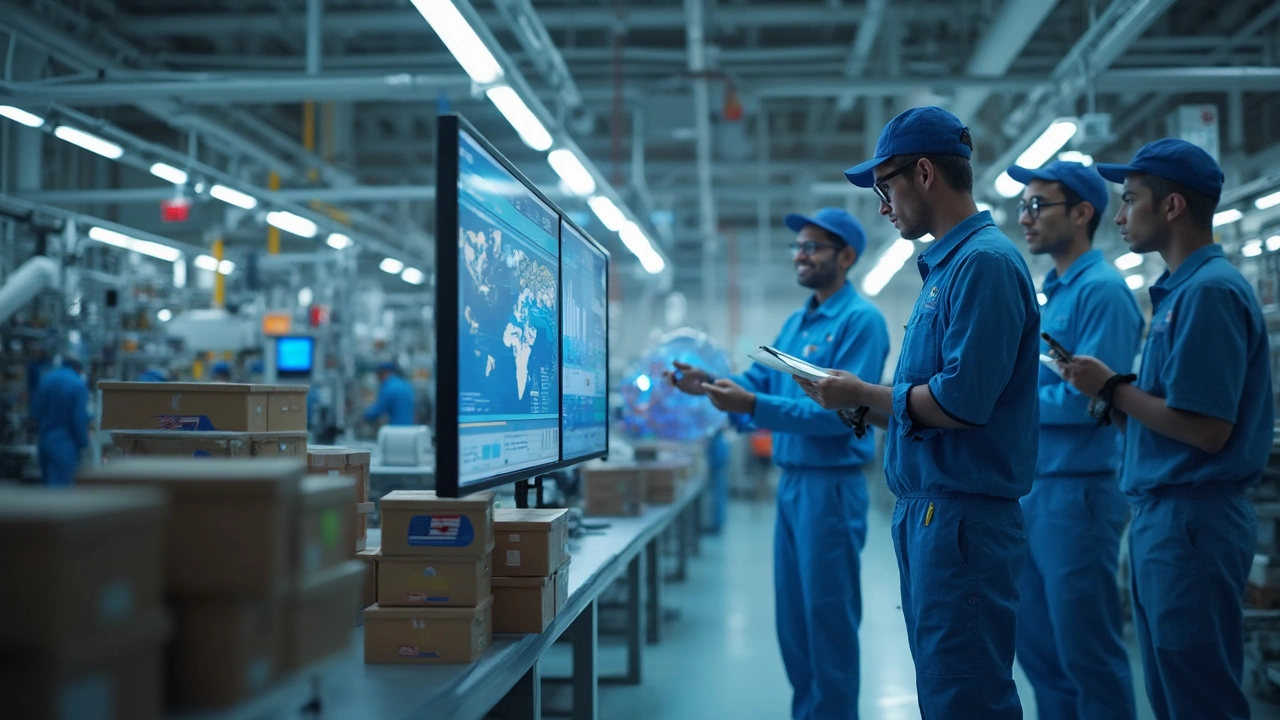
America is famous for plenty of things, but its factories helped build that reputation. Assembly lines, steel mills, roaring car plants—classic symbols of a country that built its story on making stuff. So, where exactly does the US land on the leaderboard of the world’s top manufacturers right now? You’d be surprised—maybe even frustrated—by what’s changed in this global race, and what still works in the US’s favor.
The Current US Manufacturing Rank Worldwide
Back in the mid-1900s, “Made in the USA” ruled as the gold standard. But the global chessboard has shifted. Fast-forward to 2025, and the US is ranked second in manufacturing output, just behind China. According to the United Nations’ 2023 stats, China produces more than 27% of the world’s total manufacturing output, snatching that top spot and digging in. The US sits at about 16.8%—not too shabby, but not the king of the hill anymore.
This ranking doesn’t come from opinion polls or guesses. It’s locked in by hard numbers—value added manufacturing, export growth, and overall factory output. That puts the US comfortably at number two, not slipping too far nor surging forward to catch China’s current lead. The competition behind isn’t as close as you might guess. Japan, Germany, and South Korea—those are the next giants, but each produces quite a bit less than America.
Let’s break it down with real numbers. According to the 2024 International Yearbook of Industrial Statistics, here’s a snapshot:
| Rank | Country | Share of Global Manufacturing Output (%) |
|---|---|---|
| 1 | China | 27.2 |
| 2 | United States | 16.8 |
| 3 | Japan | 6.5 |
| 4 | Germany | 5.8 |
| 5 | South Korea | 3.7 |
China took the crown over a decade ago, but the US still does more manufacturing than most other nations put together. Whether you’re into cars, planes, pharmaceuticals, or electronics, America’s assembly lines are still cranking out billions in goods every month.
Here’s the thing people usually forget: being #2 isn’t a sad story. Factories across Michigan, Texas, and California keep breaking robotics records and pushing new clean-tech gadgets out the door. The US leads in high-value sectors—think aircraft, medical equipment, and software-driven products—where quality trumps quantity. So, if you’re picturing a tumble down the ranks, it’s not quite that dramatic.
Why the US Lost the Top Spot, and What’s Stopping a Comeback
The big shift started around 2010, when rising costs and global trade deals helped China leapfrog into the lead. Cheap labor, government investment, and a wild appetite for factories made China a manufacturing juggernaut. The US, meanwhile, hit roadblocks: higher wages, old infrastructure, and red tape slowed things down. You’ll still find state-of-the-art plants in places like Ohio, but there’s no way to compete with China’s scale for everyday items like shoes or basic electronics.
But it’s not just about labor costs. China invested billions in smart manufacturing—robotics, automation, and supply chain engineering. As for the US, a lot of money went into areas outside of old-school manufacturing—think software and Wall Street. Some American companies even offshored the dirty work to keep profits up and prices down. Plus, trade policies and the spiraling cost of health insurance made it tricky to keep jobs onshore.
Certain US sectors, though, are fighting back. The auto industry, after taking a bruising in the 2000s, is roaring again, with electric vehicles and self-driving tech. Aerospace? Still a US fortress. And small, lean manufacturing startups—especially in 3D printing and robotics—are putting new life into American workshops. But getting back the #1 title? That means rebuilding supply chains, upgrading facilities, and sometimes paying more for ‘Made in America’ goods.
Let’s face it, there’s a pride factor here. Some policymakers are pushing tax breaks and funding for chip manufacturing, biotech, and renewable energy. It’s not about beating China at cheap socks—it’s about owning the tech-heavy, complicated stuff that defines the next industrial age. The CHIPS Act (2022) pumped billions into US semiconductor factories, a smart move for tech security but also for job creation.

Industries Powering US Manufacturing Today
You might picture smoky steel mills and battered toolboxes, but tech rules the modern US factory floor. Aerospace, chemicals, computers, pharmaceuticals, and advanced machinery—all these fields lead the current pack. Want a real-world example? Boeing, Lockheed Martin, Intel, 3M, and Pfizer run massive, cutting-edge operations. These are not old-school assembly lines; they’re packed with sensors and run by code as much as muscle.
The auto industry deserves its own shoutout. Tesla’s Gigafactories, Ford’s EV lines, and General Motors’ robotics labs are pumping out vehicles with more tech packed inside than most rocket launches of the 1960s. US car exports bring in billions, not just to Canada and Mexico but to Asia and Europe as well. American-made pharmaceuticals, too, top the export charts, with breakthroughs in gene therapy and vaccines grabbing headlines and helping the economy.
There’s a lot of action behind the scenes as well. Custom manufacturing—think one-off parts, advanced robotics, even bicycle frames—is coming back fast. These small shops harness 3D printing, laser cutting, and new materials, letting American businesses compete for orders that used to automatically go overseas.
Check out these sectors for a quick snapshot of where US manufacturing really punches above its weight:
- Aerospace & Defense: US leads in both commercial and military equipment
- Pharmaceuticals & Medical Devices: Rapid vaccine production and biotech breakthroughs
- Automotive: Electric vehicles, batteries, and self-driving technology
- Technology: Semiconductors, cloud servers, and custom hardware
- Food Processing: From major meatpackers to organic snack startups
None of this happens by accident. These industries benefit from tight supply chains, fierce competition, and constant innovation. As much as folks complain about jobs leaving, over 13 million Americans still work in manufacturing—more than in any other developed country except China.
Hidden Gems and Surprises in American Manufacturing
US manufacturing isn’t just about mass production. There’s a stealthy side too—niche industries and unexpected inventions. Did you know the US is still a global leader in musical instrument manufacturing, especially guitars and pianos? Or that many of the world’s race cars, satellites, and even high-end sneakers start life in American workshops?
The rise of small-batch and “reshored” manufacturers is another twist. During COVID-19, global shipping got weirdly expensive, leading many US firms to bring their operations closer to home. You’ll find startups in Nebraska printing medical implants, Indiana factories cranking out custom aircraft seats, and Washington State running a booming wine-bottling industry. It’s not always headline-grabbing, but these jobs add up—and make supply chains more reliable and less risky.
Sometimes a region just takes off. North Carolina’s "Research Triangle" saw a mini boom in biomanufacturing, fueled by partnerships with local universities. Texas keeps surprising the world by topping the charts in both wind turbines and electronics assembly. And let’s not forget California, where Silicon Valley custom manufacturing now churns out drones, smart-home gear, and robotics systems faster than you can say IPO.
If you want to spot the next wave of American manufacturing stars, track where skilled apprenticeships and technical colleges are growing. Look at local business news for stories on new plant expansions—a reliable signal that a town is about to boom.

Tips to Stay Competitive in the American Factory Race
If you’re running a shop or factory—or even just thinking about a career in this field—it pays to know how to play the long game. Here’s what works for American manufacturers right now:
- Lean into automation. Robots and advanced sensors don’t replace people; they free up skilled workers for harder jobs.
- Focus on specialties. High-mix, low-volume goods (like custom parts or advanced gear) are less likely to go overseas.
- Build local supply networks. When global crises hit, factories with local partners bounce back faster.
- Keep learning. Programs at community colleges and trade schools often partner with regional factories, combining on-the-job training with the latest in machine learning or advanced machining.
- Go green. Sustainable production not only wins PR points but also cuts costs and attracts new customers. Solar panels on the roof, efficient lighting, even sustainable sourcing—they all matter.
Using new tech, staying adaptable, and investing in people—that’s the current recipe for US manufacturing. The country may be #2 in total output, but it’s often #1 in the value of what it makes. Call it American hustle or just smart business, but the manufacturing story in the US is far from over. It keeps rewriting itself, and if history’s any clue, there’s always another surprise around the corner.




